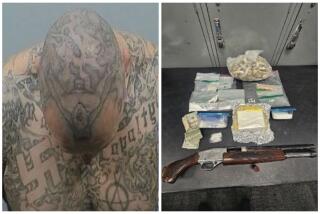DEA Breaks Up Mexico Drug Cells in U.S.
WASHINGTON — Federal agents said Monday that they have broken up three drug cells run by a powerful Mexican trafficking cartel that moved vast amounts of cocaine from Mexico to New York.
Twenty-nine people were arrested Monday in several U.S. cities as a result of a 10-month investigation documenting the increasing power of Mexican drug gangs in U.S. cities traditionally dominated by Colombian traffickers.
Also Monday, indictments were unsealed charging 56 individuals, some of whom are already in custody, with violations of federal drug laws. Indictments were handed down in New York; El Paso; Grand Rapids, Mich.; and Tucson.
“This was the first time we saw these major criminal organizations from Mexico in New York City distributing ton-levels of cocaine and taking millions of dollars of cash out,” said Thomas A. Constantine, head of the U.S. Drug Enforcement Administration.
U.S. agents have arrested about 90 people overall and seized a total of 11.8 tons of cocaine, more than 6 tons of marijuana and $18.4 million in U.S. currency in two operations that began last fall, according to federal law enforcement sources. Some of the arrests were made in Sacramento and Los Angeles, those sources said, but they provided no further details.
Constantine said the arrests and seizures are a “major incursion” into trafficking operations linked to the organization run by alleged Mexican drug lord Amado Carrillo Fuentes until his death July 4 after plastic surgery.
“Mexican drug traffickers are displacing at least some of the Colombian cocaine organizations which have traditionally dominated the New York City cocaine traffic,” Constantine said. “These organized syndicates whose leadership is based in Mexico have dumped tons of cocaine on New York City, and they are moving closer to eclipsing the Colombians and controlling the U.S. drug market.”
He estimated that Mexican-run organizations now account for the sale of at least 30% of the cocaine distributed in the United States. U.S. authorities estimate that up to three-quarters of the cocaine that reaches the United States comes through Mexico.
The expansion of Mexican-run trafficking cells to the Eastern Seaboard resembles what occurred earlier in the West, as Colombian cartels used Mexican organizations to transport cocaine into the United States, paying them with as much as one-half of each shipment rather than with cash. The Mexicans then distributed their share of the product in California and the Midwest, according to DEA intelligence.
The focus on New York began in October, when DEA intelligence received information that a major drug organization was operating “out of Juarez,” across the Mexican border from El Paso, into the eastern United States, Constantine said.
He said U.S. agents had no “hard information” on the report until Oct. 30, when Todd Brackhahn, a trooper for the Texas Department of Public Safety, stopped a van with New York license plates and found $2 million in cash in a hidden compartment. Through investigation, he learned that the money and the van’s occupants, two Mexican nationals, were headed for Juarez.
The next break came Dec. 3, when a state and local narcotics enforcement group got a tip that “some funny things” were going on in a Tucson warehouse. Armed with a search warrant, agents seized 5.3 tons of cocaine.
They also determined that an additional 6.6 tons of the drug had been taken to New York just days before in trucks allegedly driven by employees of a Battle Creek, Mich., trucking firm, the law enforcement sources said.
Among those arrested Monday were seven drivers for the trucking concern, including its owner.
On Dec. 13, Brackhahn stopped a big-rig for speeding near Tyler, Texas, and found 2,700 pounds of marijuana in a secret compartment. An investigation determined that the truck was bound for the New York suburbs of New Rochelle and Pelham and that the marijuana had come from an El Paso warehouse.
Surveillance of the El Paso warehouse by DEA, FBI and Texas troopers established that on Dec. 15--two days after Brackhahn had stopped the 18-wheeler--1.5 tons of cocaine were taken by another truck from the same facility, and it was seized by federal agents.
At the same time, federal agents found that the cocaine and marijuana movements were being directed by two Juarez-based cells, both working for Carrillo, the law enforcement sources said.
The investigation then gained momentum with significant cash seizures, including $3.25 million from the back of an 18-wheeler in New York state, then $5.65 million in “street amounts”--$10 and $20 bills--in El Paso from a secret roof compartment in one of the trucks belonging to the Battle Creek firm.
On June 11, agents seized 1,350 pounds of cocaine from a warehouse near Jersey City, N.J., and arrested five Mexican nationals. The warehouse, rented by the Mexicans, could hold “multiple” 18-wheelers, and it was established that the same group had rented warehouses in New Rochelle and Pelham.
The second investigation was directed at another Mexican cell and began in Imperial County in California a year ago. It focused on a transportation and distribution cell also linked to the Carrillo organization, which smuggled at least 1.5 tons of cocaine a month by truck across the country, according to Justice Department officials. Mexican nationals allegedly concealed the cocaine in crates of vegetables and fruits.
(BEGIN TEXT OF INFOBOX / INFOGRAPHIC)
Far-Flung Drug Network (Southland Edition, A8)
Drug Enforcement Administration officials made arrests in several cities Monday. Since the operation against the Mexican drug cartel began last fall, the DEA has confiscated about 11.8 tons of cocaine, more than six tons of marijuana and $18.4 million in cash. Twenty-nine people were arrested Monday in these cities.:
San Diego
Albuquerque
El Paso
Tyler, Tex.
Rockford, Ill.
Chicago
Battle Creek, Mich.
Jersey City, N.J.
New York
Source: Associated Press, Reuters
More to Read
Sign up for Essential California
The most important California stories and recommendations in your inbox every morning.
You may occasionally receive promotional content from the Los Angeles Times.










